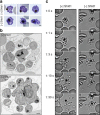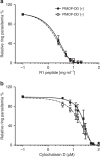An essential malaria protein defines the architecture of blood-stage and transmission-stage parasites
- PMID: 27121004
- PMCID: PMC4853479
- DOI: 10.1038/ncomms11449
An essential malaria protein defines the architecture of blood-stage and transmission-stage parasites
Abstract
Blood-stage replication of the human malaria parasite Plasmodium falciparum occurs via schizogony, wherein daughter parasites are formed by a specialized cytokinesis known as segmentation. Here we identify a parasite protein, which we name P. falciparum Merozoite Organizing Protein (PfMOP), as essential for cytokinesis of blood-stage parasites. We show that, following PfMOP knockdown, parasites undergo incomplete segmentation resulting in a residual agglomerate of partially divided cells. While organelles develop normally, the structural scaffold of daughter parasites, the inner membrane complex (IMC), fails to form in this agglomerate causing flawed segmentation. In PfMOP-deficient gametocytes, the IMC formation defect causes maturation arrest with aberrant morphology and death. Our results provide insight into the mechanisms of replication and maturation of malaria parasites.
Figures










References
-
- World Health Organization. World Malaria Report 2014, 1–142 (2014).
-
- White N. J. et al.. Malaria. Lancet 383, 723–735 (2014). - PubMed
-
- Francia M. E. & Striepen B. Cell division in apicomplexan parasites. Nat. Rev. Microbiol. 12, 125–136 (2014). - PubMed
-
- Tilney L. G. & Tilney M. S. The cytoskeleton of protozoan parasites. Curr. Opin. Cell Biol. 8, 43–48 (1996). - PubMed
Publication types
MeSH terms
Substances
Grants and funding
LinkOut - more resources
Full Text Sources
Other Literature Sources

